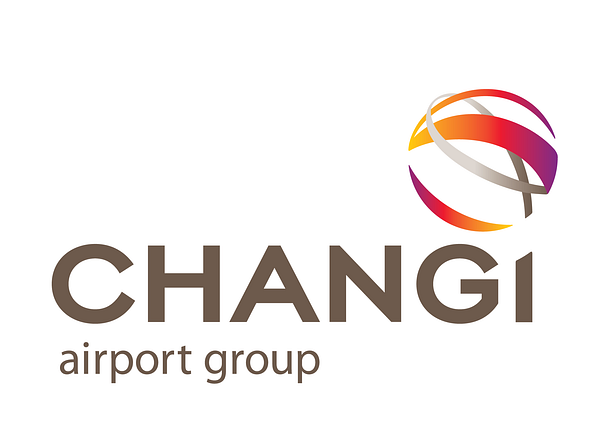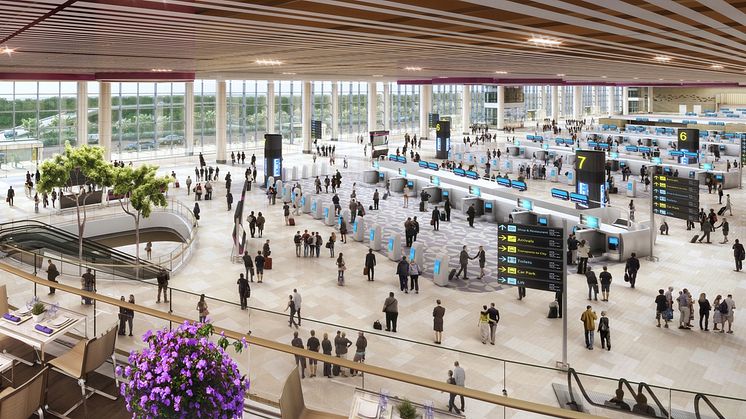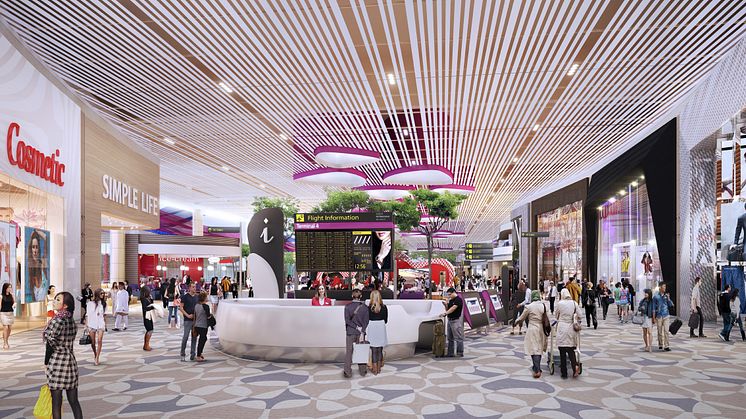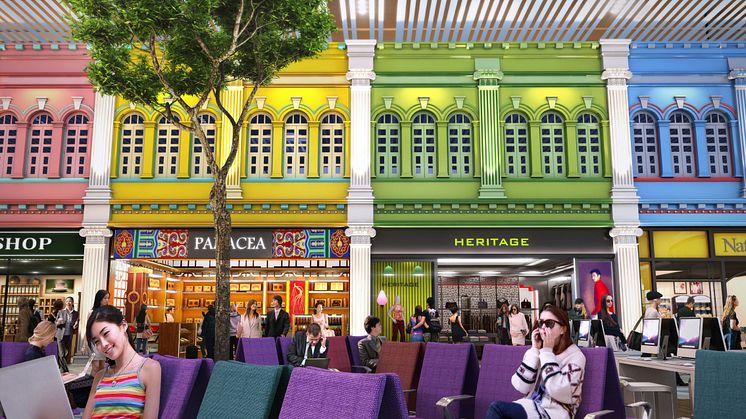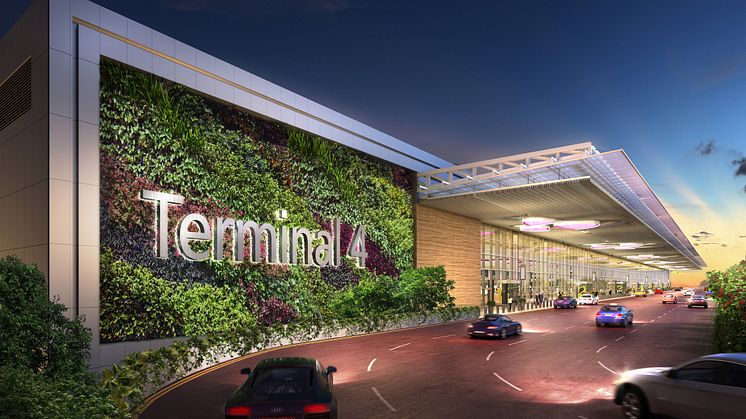
Press release -
Changi Airport breaks ground for Terminal 4
Singapore Changi Airport today broke ground for the construction of Terminal 4 (T4), that will come with design and process innovations to redefine passengers’ travel experience, raise operational efficiency and manpower productivity for airlines and airport agencies.
At the groundbreaking ceremony graced by Mr Lui Tuck Yew, Minister for Transport, guests were given the first glimpse of the design of Changi Airport’s newest terminal – lush and comfortable, yet intimate, with touches of Singapore culture.
A terminal for fast and seamless travel
Besides delivering the premium airport experience that Changi Airport is renowned for, T4 will also see, for the first time at Changi, the extensive roll-out of a suite of fast and seamless travel (FAST) initiatives. These self-service and automated options will be offered at check-in, bag drop, immigration clearance and departure-gate boarding.
As self-service kiosks will be available at T4 throughout the day, passengers can choose to check-in at their own convenience before their flights without waiting in queues during peak periods. Those who are unfamiliar with the self-service options will be assisted by roving check-in service agents.
T4’s FAST initiatives are part of a global trend towards self-service options in airports and necessary in Singapore which faces a very tight labour market, especially in the ground handling and security sectors.
Local inspiration
The design of T4, based on a simple and functional architectural concept, is undertaken by a design consortium led by SAA Architects Pte Ltd, with members including UK architecture firm Benoy Ltd. It draws inspiration from an orchid petal.
To be built on the site of the former Budget Terminal (BT), T4 will be a two-storey, 25-metre-high building with a gross floor area of 195,000 square metres. The terminal’s showpiece is a 300-metre-long Central Galleria which separates the public zone from the restricted zone. A first for Changi Airport, T4’s visual-transparent concept will provide clear visibility from the Check-in Hall of the attractive offerings in the Transit Lounge.
Besides creating a sense of openness, greenery and natural lighting – a Changi Airport signature – will also be used to enhance the ambience of the terminal. And taking public feedback into consideration, the T4 transit area will feature local culture and heritage-theme features, such as retail stores with facades of old Peranakan shop houses. Retail and F&B offerings at T4 will be comparable to the range and variety offered at Changi Airport’s other terminals.
In another Changi Airport first, T4 will sport a new walk-through retail concept. Featuring merchandise from the top two product categories – liquor and tobacco, and perfumes and cosmetics – departing passengers will find it more convenient to shop before boarding their flight. In all, T4 will feature more than 15,000 square metres of space dedicated to shopping and dining, several times more than what was previously available at the BT.
Serving both full-service and low-cost carriersIn terms of floor area, the T4 building will be about seven times larger than the BT, with 17 contact stands for narrow-body aircraft and four for wide-body aircraft. These stands will come with aerobridges, increasing convenience and accessibility for passengers. Designed to enable quick turnaround of aircraft, T4 will have the flexibility to serve both regional full-service and low-cost carriers.
T4 will also have its own Ramp Control Tower to oversee and manage aircraft movements in the apron and taxiways around the terminal. This tower is needed to enhance the Changi Airport air traffic controllers’ visual line of sight of aircraft parking stands and associated taxiways near the southern end of Runway 2. The 68-metre tall Ramp Control Tower will provide clearance to pilots on when they can push back from the gates, as well as give instructions on which taxiway to be used, before handing over communications to the Changi Air Traffic Control Tower.
Optimising manpower resources
In keeping with Changi Airport’s passenger-centric model, the terminal layout of T4 has been designed to provide ease of wayfinding and accessibility. The immigration and pre-board security screening areas will be centralised at the south end of the terminal, so as to create a clear single directional path for passengers towards their boarding gates.
Compared to the decentralised model, this reduces manpower requirements by improving deployment efficiency of immigration and security officers and removes the need for additional equipment at multiple gate holdrooms in the case of security screening. The coupling of both functions at the same location also frees up space for more passenger facilities.
While T4 is expected to handle mainly origin-destination traffic, a dedicated free airside shuttle between T4 and Terminal 2 will be provided to cater to passengers with onward connections on non-T4 airlines.
Ready for future growth
With the ability to handle 16 million passenger movements a year, T4’s completion in 2017 will bring Changi Airport’s total annual passenger capacity to 82 million. To support the terminal’s operations, another 17 narrow-body and nine wide-body aircraft stands are being built at a land plot south of Terminal 3, in preparation for increased demand for aircraft parking space as air traffic continues to grow into the next decade. A bridge across Airport Boulevard will be constructed to enable buses and other airside vehicles to move from T4 to these aircraft stands. To facilitate the smooth movement of passengers boarding aircraft at the remote stands, T4 will also house a centralised departure bus lounge with up to nine bus bays.
Over at the T4 landside, there will be up to 1,500 parking spaces for private vehicles in an open-air car park in front of the terminal as well as in a multi-storey car park. Both car parks will be connected to the terminal via sheltered links. A regular free shuttle service between T4 and the other terminals will also be provided for the convenience of passengers and visitors.
Rethinking travel
Mr Lee Seow Hiang, Chief Executive Officer of Changi Airport Group, said: “Terminal 4 is set to challenge and redefine the way we travel. We have conceptualised and designed the terminal for passengers who view the time spent at the airport as very much part of their travel and holiday. Hence, we are introducing new breakthroughs that will enhance their travel experience and excite them at the same time.
“With T4, we are rethinking travel, exploring how key operational functions can be designed differently to optimise process flow, interior space, as well as manpower resources. We are also challenging ourselves to deliver an even higher level of the Changi Experience, by creating a boutique ambience and reflecting thoughtfulness for our passengers through the details in our design. In the aspects of architecture, layout and technology, we have future-proofed the terminal so that it can adjust to changing requirements of the industry.”
“Despite its relatively small size, our vision is for T4 to be an iconic terminal, setting new benchmarks – for passenger experience, operational efficiency and manpower productivity for our airport partners. We look forward to welcoming passengers to T4 in 2017 with a new Changi Experience; one that will continue to be personalised, stress-free and positively surprising,” Mr Lee added.
Related links
Topics
Categories
About Changi Airport Group
Changi Airport Group (Singapore) Pte Ltd (CAG) (www.changiairportgroup.com) was formed on 16 June 2009 and the corporatisation of Singapore Changi Airport (IATA: SIN, ICAO: WSSS) followed on 1 July 2009. As the company managing Changi Airport, CAG undertakes key functions focusing on airport operations and management, air hub development, commercial activities and airport emergency services. CAG also manages Seletar Airport (IATA: XSP, ICAO: WSSL) and through its subsidiary Changi Airports International, invests in and manages foreign airports.
Changi Airport (www.changiairport.com) is the world’s most awarded airport with more than 430 accolades received since it opened in 1981. To serve passengers and visitors from the world over, there are over 350 retail stores and 120 F&B outlets across the airport's three terminals. Changi handled more than 51 million passenger movements in 2012, an annual record. Today, it serves some 110 airlines flying to over 250 cities in about 60 countries and territories worldwide. A flight takes off or lands at Changi roughly once every 100 seconds.
